If you’re looking for a stunning houseplant to add to your collection but worried you’ve got a black thumb, fear not. I’ve got just the plant for you—or actually, many plants!
If you haven’t met her already, I’m honored to introduce you to the genus Aglaonema, better known as the Chinese evergreen.
An absolute classic in the houseplant hobby and ubiquitous in homes, malls, and offices, this species may just be the perfect combination of decorative and easy to keep alive—so easy, in fact, that you can even just grow these plants in water!
Members of the Aroid family (Araceae), the 21 different species of Aglaonema are naturally found in warm and humid forests in Asia and New Guinea. Here, they form part of the shaded undergrowth, which means they’ve evolved to make do with a little less light than many other plants.
In their native range, Chinese evergreens have long been grown as an ornamental plant, but it took quite a bit longer for the species to pick up steam in the West. It was apparently introduced in 1885, but it took almost a hundred more years before nurseries caught on and began mass-producing it.
Once they did, though, the plant became virtually unstoppable!
As you’ve probably seen, the world of Aglaonemas can be a dizzying one to wade through. So to help you find the perfect plant for your home, I’ve put together this list of the best and easiest Aglaonema varieties to grow, even if you’re a total beginner at keeping houseplants!
Disclosure: If you shop from my article or make a purchase through one of my links, I may receive commissions on some of the products I recommend.
Best Aglaonema varieties
There are few houseplants that appear in as many different colors and shapes as the genus Aglaonema. It’s very easy for nurseries to create new cultivars as the result of the development of all sorts of techniques for things like forced blooming and more effective pollination. This is underlined by the amount of patents given out for Chinese evergreen plants.
A quick look at Google Patents reveals over 10 pages of Aglaonema cultivars, and that’s just the varieties that were officially registered. Many of them don’t even have their own names names, but were instead given codes like ‘TWYAG0054’ or ‘UF-742-3.’
Some nurseries or individuals have dozens of patented cultivars in their name. Florida’s Sunshine Foliage World nursery, for example, owns over 25!
Related: What Are Cultivars, Varieties, Hybrids and More: Layman’s Guide to Plant Taxonomy
In order to prevent you from losing the forest for the trees, I’ve put together a list of the most popular, coveted, and beautiful Aglaonema varieties out there (and sprinkled in a few of my personal favorites, too).
We’ve got green plants, pink plants, white plants, wide-leaved plants, narrow-leaved plants, spotted plants, marbled plants… there truly is an Aglaonema for everyone.
Let’s dive in!
Where to buy Aglaonema plants:
Aglaonema varieties: species
Almost all of the Chinese evergreens we’ll be discussing here are cultivars and hybrids. This means they were selectively bred and crossed, combining wild type Aglaonemas into new ones. Before we have a look at those, let’s give the originals a bit of attention. These are actual species, scientifically speaking, and can be found in the wild.
Aglaonema commutatum
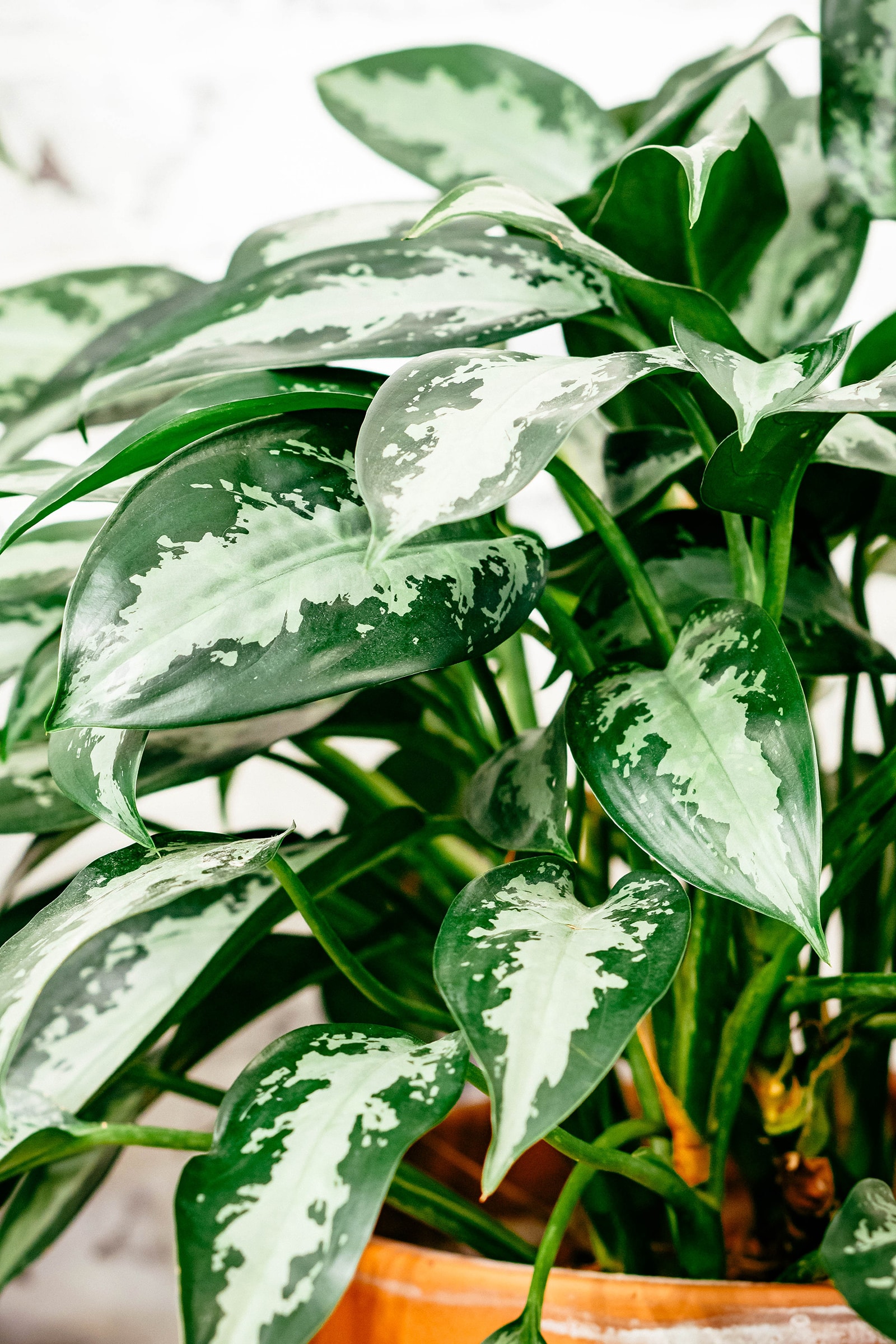
OG Chinese evergreen alert! Aglaonema commutatum holds a particular place in the Aglaonema family. It’s one of the original Chinese evergreens, so to speak, and the one that has most extensively been used to create the range of cultivars that we know today.
Nurseries hybridized and selectively cultivated it to create many of the other plants we’ll be discussing here. ‘Crete’, ‘Silver Bay’, ‘Silver Queen’ and others are all examples of commutatum cultivars.
Aglaonema commutatum is naturally found in the Philippines and the Indonesian island of Sulawesi. It’s also an invasive plant in a few areas, but surprisingly difficult to find in plant stores: it seems its hybridized “offspring” have overtaken it in popularity.
Different forms of Aglaonema commutatum exist, among which ‘Treubii’ and ‘Maculatum’ are the most common.
Aglaonema rotundum

Naturally found on the Indonesian island of Sumatra, Aglaonema rotundum is hailed by some houseplant enthusiasts as the most beautiful original Chinese evergreen species of them all. Its leaves are shiny and dark green, with a whitish or pink midrib, almost like the popular pinstripe prayer plant from the genus Calathea.
Aglaonema rotundum has been extensively hybridized, but cultivars closer to the original plant are also sometimes available. Look for ‘Aceh’, whose leaves are so dark green they’re almost black, or ‘Tiger’, which sports extra bright pink leaf veins.
Aglaonema nitidum
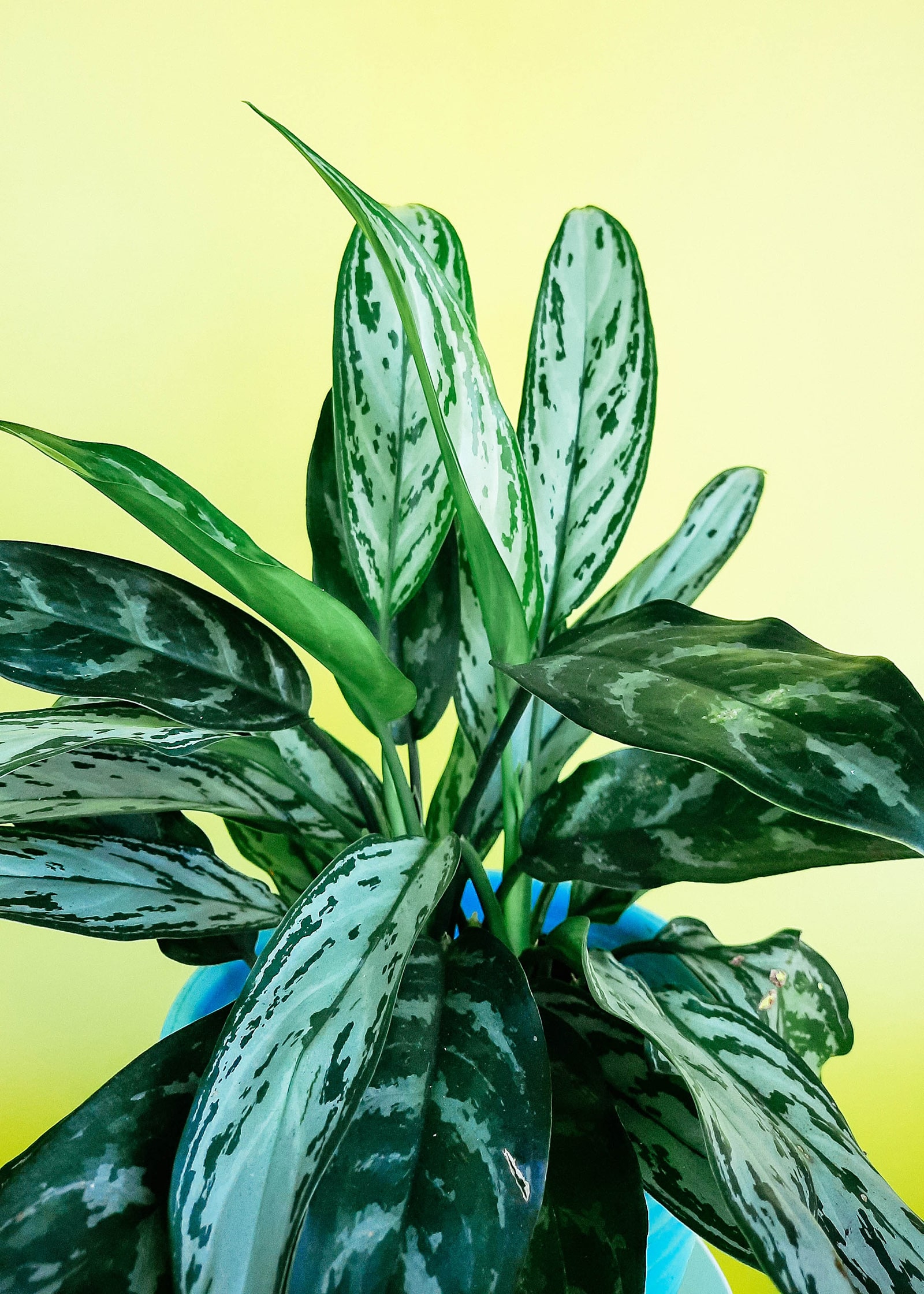
Like most Chinese evergreens, Aglaonema nitidum is naturally found in Southeast Asia, where it grows in forested areas. Its oval foliage is usually fully green, although flecks of silver can also appear. This is something nurseries have made use of to create stable silver-patterned cultivars.
This isn’t the largest Chinese evergreen species, as it only grows to a maximum height of around 3.3 feet, but it is one of the bushier ones.
Aglaonema philippinense
Although this isn’t exactly a Chinese evergreen you’ll come across often, it’s worth a mention here because it’s a parent plant for many of the long-leaved (lanceolate) Aglaonema cultivars. This especially applies to the ‘Stenophyllum’ variation, which sports very elongated foliage.
As its name suggests, Aglaonema philippinense is mostly naturally found in the Philippines, although it also pops up on the Indonesian island of Sulawesi.
Other Aglaonema species commonly used in the hybridization of Chinese evergreen houseplants include Aglaonema costacum, brevispathum, crispum, pictum, simplex, and more.
Aglaonema varieties: classics
Let’s start with the classics! And you’ll see a pattern here (aside from the one on these plants’ lovely variegated leaves). The majority of the green Aglaonemas were created significantly earlier than the pink and red varieties. Those have been popping up more recently, mostly since the ‘90s, so we’ll discuss them in the “Modern” section down below.
Aglaonema ‘Silver Queen’
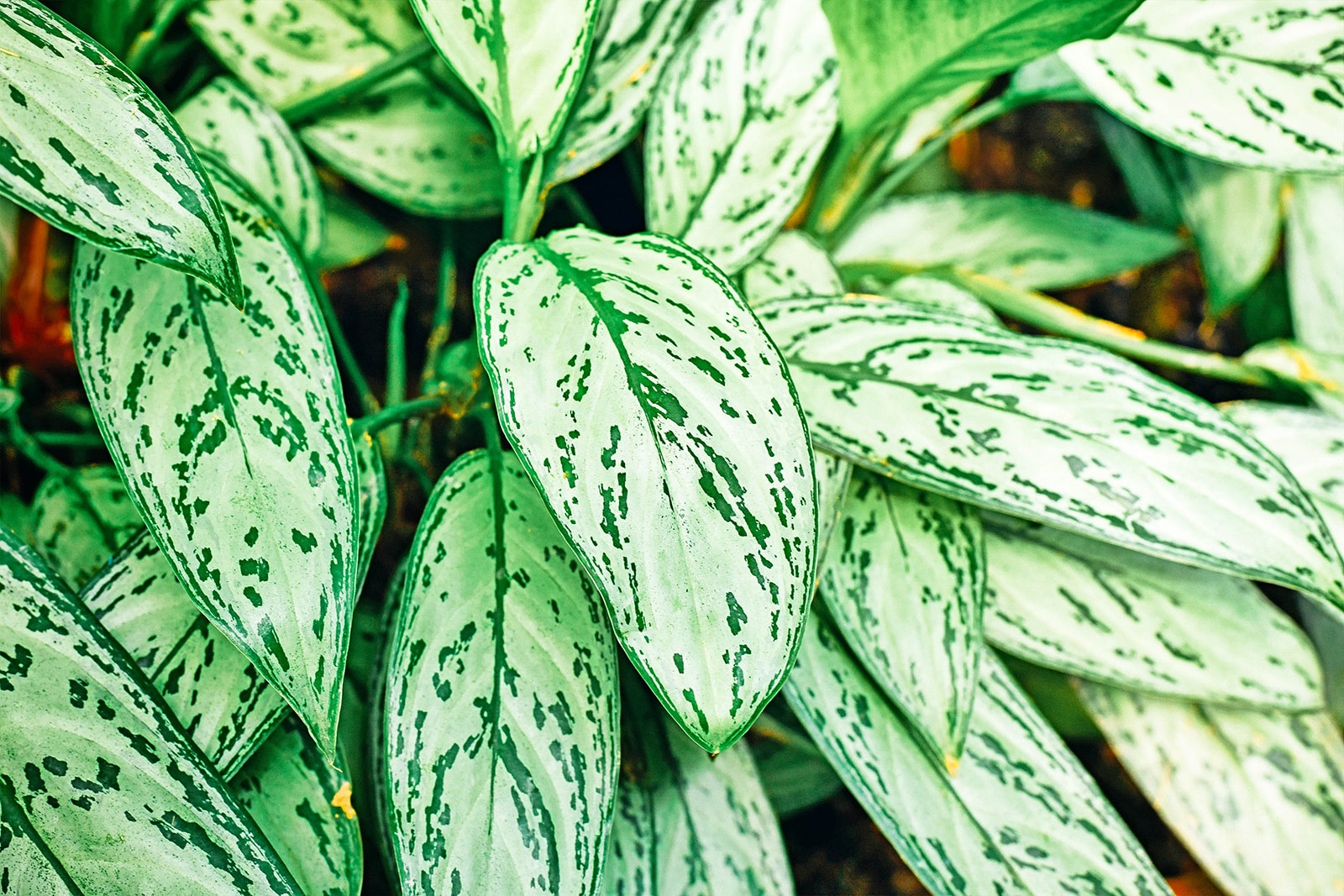
One of the oldest Chinese evergreen cultivars around! In fact, this one dates back to the ‘80s, having been produced in Florida using Aglaonema commutatum ‘Treubii’ and Aglaonema nitidum ‘Curtisii’ as parents.
Despite being pretty ubiquitous, Aglaonema ‘Silver Queen’ never gets boring. Its leaves are longer than that of many other varieties, though not quite as lanceolate as‘Cutlass’ or ‘White Lance’, which are discussed below in the section on ‘modern’ Aglaonemas.
They’re mostly silvery green in color, but feature an almost feathery dark green pattern. Do keep in mind that this variety is relatively sensitive to cold damage and doesn’t appreciate temperatures below 55°F.
Aglaonema ‘Silver Bay’

If you spot a Chinese evergreen plant at your local plant store, there’s a very good chance it’s Aglaonema ‘Silver Bay’. The same goes for the specimens found at shopping malls and offices.
This unpatented cultivar has apparently been around since 1992. It was produced by the Mid-Florida Research and Education Center, which went on to create a whole range of cultivars using the ‘Bay’ denomination. We’ll be discussing a few on this list!
The parent plants for ‘Silver Bay’ were two cultivars named Aglaonema ‘Manila Whirl’ and Aglaonema nitidum ‘Ernesto’s Favorite’. This pretty cultivar has dark green leaves with silver centers, is easy to care for and can grow huge if you provide the right growing conditions.
Even when kept in lower light spots, it’ll still survive and even continue putting out new foliage. Combine this with its low price and you’ve got a winner on your hands!
It’s not likely to happen, but if you can’t find Aglaonema ‘Silver Bay’ locally, one good alternative I’ve found is ‘Cleopatra’.
Aglaonema ‘Maria’
Another very common sight in plant stores and nurseries is Aglaonema ‘Maria’, one of the classic green varieties. This is an unpatented cultivar that has been around for a good while and has actually been used to produce some of the other green plants on this list.
‘Maria’ is easy to recognize by its relatively elongated leaves and pretty feathered green and silvery pattern. This is another easy-care Chinese evergreen that can withstand relatively low-light conditions, although it will grow more quickly if you place it close to a window.
Aglaonema ‘Jubilee’
‘Jubilee’ is a pretty green Aglaonema variety, not dissimilar in looks to cultivars like ‘Silver Bay’. It’s a dark green leaved plant with light silvery green in the leaf centers. The silver is mottled at the edges to make for a nice variegated effect. This Chinese evergreen apparently likes quite a bit of light.
Since this cultivar’s patent is publicly available, we know that it was first produced by Florida nursery Sunshine Foliage World in 1986. Its parents were Aglaonema nitidum ‘Curtisii’, a plant that many of the Chinese evergreens on this list have in their parentage, and an unpatented light green-leaved cultivar known as Aglaonema ‘Manilla’. The patent expired in 2016.
Did you know? Aglaonema ‘Jubilee’ has a little sister named ‘Jubilee Petite’, which is more compact. Great if you’re a little short on space for plants!
Aglaonema varieties: modern
Aglaonema ‘Pictum Tricolor’

Let’s continue the list with the most coveted Chinese evergreen cultivar of all: Aglaonema ‘Pictum Tricolor’. With its camouflage-patterned leaves in three shades of green, this is a true eye-catcher, but it’s challenging to find and tends to be expensive. Prices over $100 for a small specimen aren’t uncommon!
Unfortunately, ‘Pictum Tricolor’ is also one of those plants that attract scammers due to its steep price. Don’t fall for ads offering seeds for sale (it’s difficult to obtain seed from this species, so it’s rare to find real ones), wet stick cuttings without leaves (it could be any plant!), or suspiciously cheap plants supposedly shipped from Indonesia. You’re more likely to end up with weeds or never receive your order at all.
Aglaonema ‘Crete’
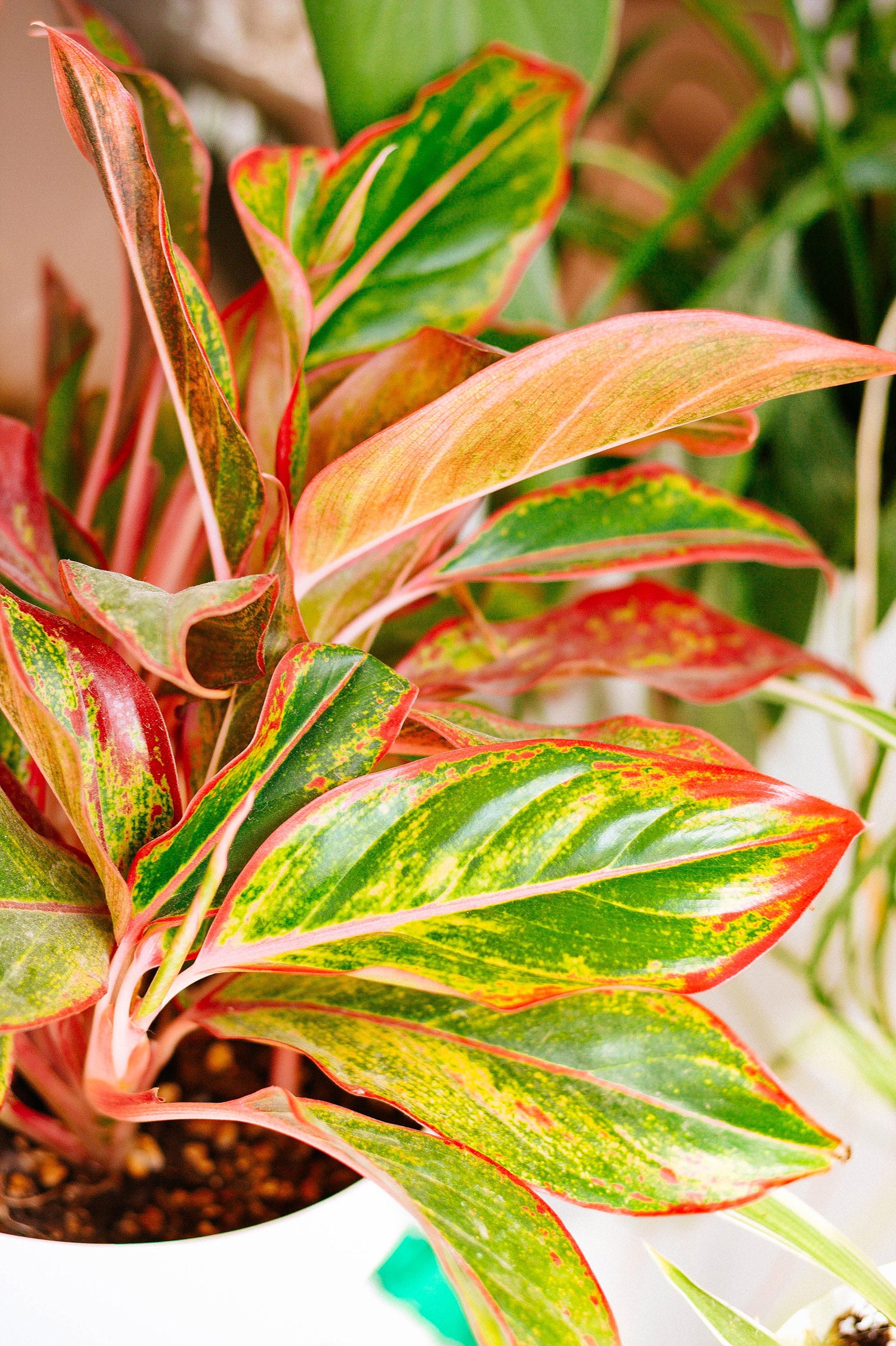
One of Europe’s hottest Chinese evergreen cultivars right now and quickly gaining popularity in the US too! In the last year or two, nurseries have started putting out loads of these beauties, and I’m not surprised.
‘Crete’ is a gorgeous Aglaonema with mottled green leaves characterized by their bright pink edges. The leaf stems are a lovely light pink. I’ve found this one easy to grow and pretty prolific.
Aglaonema ‘Prestige’

Another beautiful multicolored number that has made its way onto my list of personal favorites, Aglaonema ‘Prestige’ can be recognized by its dark green foliage with pink leaf veins. In fact, when given enough light, almost its entire leaves can be light to medium pink in color, with just a little spotted green at the edges.
My ‘Prestige’ is a quick grower that puts out beautifully colored leaves, despite not being right next to a window. A fantastic choice if you’re looking for a colorful houseplant but don’t want to deal with the fussier species.
Aglaonema ‘Lady Valentine’
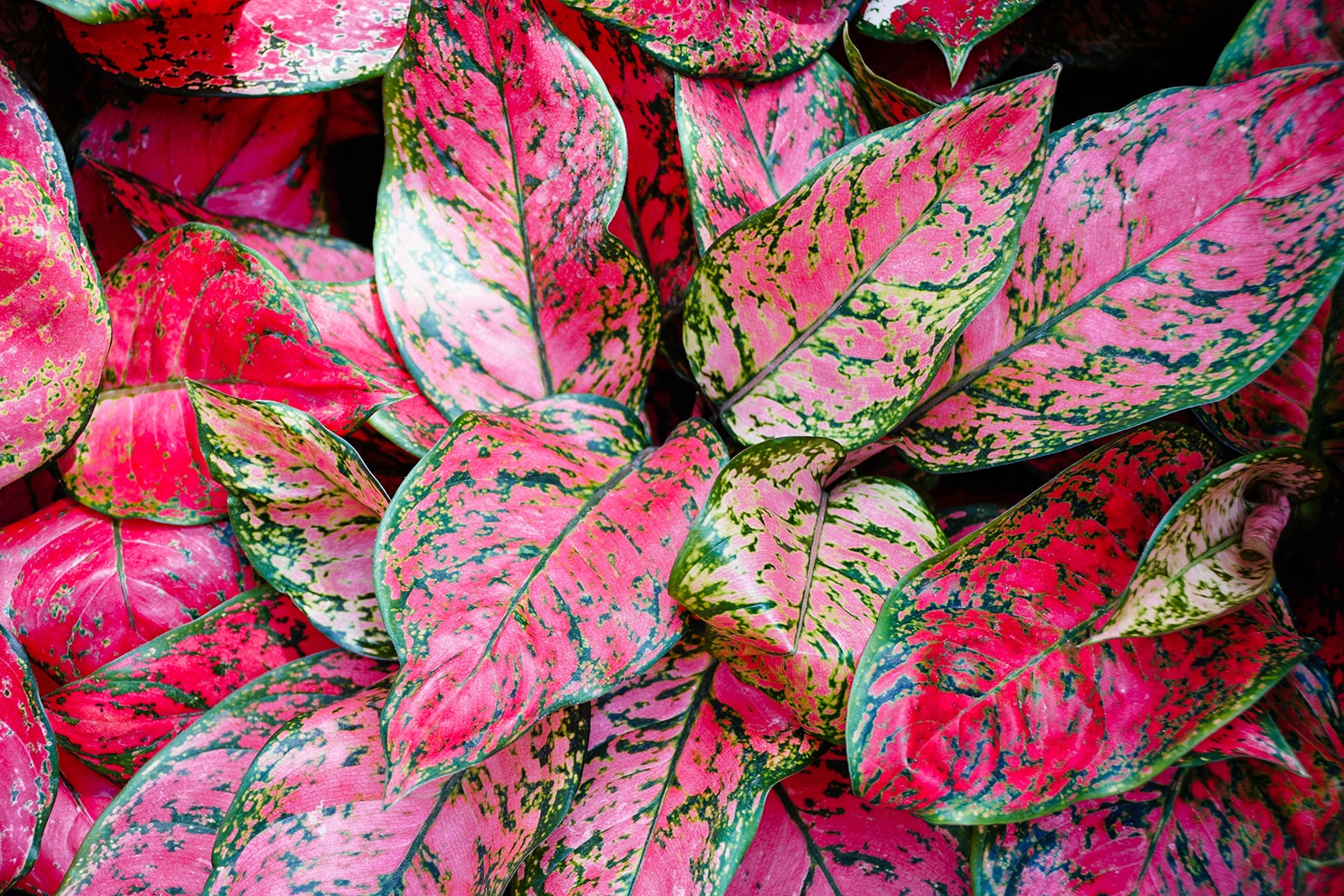
If the aforementioned ‘Prestige’ still isn’t quite the right level of pink for you, fear not. There are Chinese evergreens out there that actually have almost no green on their leaves when grown in well-lit environments! One great example is Aglaonema ‘Lady Valentine’, which produces almost entirely rose-colored foliage interspersed with only minimal amounts of green spotting.
Originating from Thailand, like many of the pink Aglaonemas, this cultivar is now relatively popular in both the US and Europe. Be sure to place yours next to a window that gets plenty of bright indirect light if you’d like to see it in its full splendor.
Did you know? A 2016 study suggests that red-leaved Aglaonema cultivars, like ‘Lady Valentine’, are more resistant to cold than their green-leaved cousins. They still can’t handle frost, but you don’t have to worry as much about them being fussy during the winter months.
Aglaonema ‘Siam Aurora’

The ‘Siam Aurora’ cultivar is similar in looks to ‘Crete’. Both are “lipstick” varieties, which refers to Chinese evergreen cultivars whose leaves are mostly green in the center, but have a striking line of color running all along the leaf edges. Some plants feature larger blocks of the typical intense pink color, while in others the pink is more of a pastel shade.
By the way, there are loads of different Chinese evergreen cultivars to look for that carry the ‘Siam’ denomination. If ‘Siam Aurora’ isn’t your thing, why not go for ‘Siam Orange’, ‘Siam Pink’, or ‘Siam Jade’?
Aglaonema ‘Chocolate’
Wait a second, why does this Chinese evergreen cultivar look so different from all of the other ones we’ve discussed so far? Well, that’s because it’s not part of the huge group of Aglaonema commutatum & Co. cultivars. Instead, it’s a cultivar of Aglaonema rotundum, that more round-leaved and stripe-veined species from Sumatra.
Aglaonema ‘Chocolate’ is characterized by its very dark green leaves with a slight brown tinge. The leaf veins are pinkish in color, especially on the backside of the leaves, which have a distinct pinkish-brown tinge. Truly a very nice plant to look at!
The only downside is its rarity: There aren’t many shops out there that carry the ‘Chocolate’ cultivar
Aglaonema ‘Pink Moon’
One of the most whimsical Chinese evergreen varieties I’ve come across is ‘Pink Moon’. Imagine: a plant with emerald green leaves and a pastel pink midrib. The very fine leaf veins are a cream color. There are cream to pinkish flecks all across.
I haven’t actually been able to figure out this cultivar’s parent plants, since it seems like no one knows, but they must be real beauties!
‘Pink Moon’ is on the rarer side and you’re not likely to find it for sale in your local plant store, but luckily, it shouldn’t be impossible to obtain one if you search online.
Aglaonema ‘Cutlass’
If you’re into the long-leaved varieties of Aglaonema, ‘Cutlass’ might be just the plant for you. It’s patented as part of the Stars of India™ collection by Indian company Kayesgees, which is a big supplier of Aglaonemas for the US market. The cultivar’s extra-long lanceolate foliage really makes it a beautiful addition to the home.
The leaves are a light silvery-green in color, rimmed with a darker shade of green that also appears on the midrib and speckles the entire surface. This cultivar is similar to ‘White Lance’, which we’ll discuss below, although that one lacks the charming dark green flecks.
There is also a very similar Aglaonema out there known as ‘Muklass’, which was patented by the same company.
Aglaonema ‘Golden Fluorite’
Imagine Aglaonema ‘Prestige’, which we discussed previously, but with an added golden tinge. That’s Aglaonema ‘Golden Fluorite’!
Although it has the same pink midribs and leaf veins, this one is characterized by the fact that the entire leaf is a sort of faded gold in color, especially on newer foliage. Definitely a difficult Chinese evergreen to overlook, especially if you take care to give it enough light.
Because ‘Golden Fluorite’ has been featured as one of Costa Farms’ Trending Tropicals®, it should be relatively easy to find in the US, especially online.
Aglaonema ‘Pink Dalmatian’

It’s not a surprise that growers ended up calling this ultra-speckled Chinese evergreen ‘Pink Dalmatian’! Wide, dark green foliage is mottled with large amounts of pastel to deep pink spots to make for another gorgeous Aglaonema cultivar that really stands out among other houseplants.
This one, too, is part of the Trending Tropicals® collection by Costa Farms, meaning that US-based houseplant enthusiasts shouldn’t have too much trouble finding one either in-store or online.
Aglaonema ‘White Lance’

Similar to ‘Cutlass’ in looks, as its name suggests, Aglaonema ‘White Lance’ is another cultivar with elongated (lanceolate) foliage, bred from parent plants called ‘Bayonet’ and ‘Ernesto’s Favorite’. Its leaves are a pale, solid silvery-green in the center with dark green around the edges.
I love the long-leaved Chinese evergreen varieties because they’re very prolific and quickly turn into nice and lush plants with the right care. Perfect if you’re looking for something relatively dense and bushy.
By the way: there’s also a ‘Black Lance’ Aglaonema, which sports darker green on the leaf edges.
Aglaonema ‘Tigress’
Eye-catcher alert! The pink Chinese evergreen varieties are often considered the most striking, but this silver and dark green cultivar can absolutely compete with them. Like ‘Cutlass’ and quite a few others, ‘Tigress’ is part of the Stars of India™ collection by Kayesgees.
Aglaonema ‘Tigress’ is relatively similar in looks to the aforementioned ‘Maria’, except that the stripes on its foliage are even more defined and symmetrical. This makes for a gorgeous feathery effect on the slightly elongated leaves.
Aglaonema ‘Wishes’
‘Wishes’ looks like someone sprinkled bright pink confetti on a dark green Chinese evergreen! If the aforementioned ‘Lady Valentine’ and ‘Prestige’ had a baby, it would probably be similar to this cultivar.
Beautifully variegated, the pink tones on this one will turn almost red if you expose it to plenty of light. Lower light, though, will highlight the greens, so it’s actually kind of up to you how you’d like your plant to look.
Aglaonema ‘Sparkling Sarah’
Although Aglaonema ‘Sparkling Sarah’ is characterized by its mottled pink tones, it doesn’t overdo them, keeping the color limited mostly to the leaf veins.
A beautiful, low-light proof Chinese evergreen cultivar, this one is part of a patented, mass-produced collection called Jazzed Gems™. The collection contains various Aglaonema cultivars with names like ‘Moonstone Miles’, ‘Wintry Winehouse’ and ‘Sapphire Suzanne’; too many to discuss here, but worth checking out.
Aglaonema ‘Spring Snow’

One of the first white Chinese evergreen varieties on the list, ‘Spring Snow’ is among those Aglaonemas that are very easy to confuse with certain Dieffenbachia cultivars. The leaf shape, growth pattern, and stems all look very similar, but there are some subtle differences that you’ll learn to recognize!
Aglaonema ‘Spring Snow’ is characterized by its dark green leaf base mottled with a generous confetti of whitish-cream specks. A particularly bushy cultivar, this one is easy to grow and very nice to look at.
If you can’t find Aglaonema ‘Spring Snow’, you could consider ‘Snow White’ or ‘First Diamond’ instead.
Aglaonema ‘Golden Bay’
Why hello! Although Chinese evergreen cultivars can become a little repetitive, what with each nursery wanting to put out their own full collections, sometimes you come across a pretty unique one. That’s what ‘Golden Bay’ is!
Although it looks similar to ‘Silver Bay’ at first glance, ‘Golden Bay’ sports creamy-yellow stems and a striking yellow leaf midrib. There may also be slight yellow speckling present on this patented cultivar’s foliage. It’s cold-hardy down to 45°F, which is quite a bit lower than some of the more fussy Aglaonemas!
Like much of the ‘Bay’ family, this one was produced by the Mid-Florida Research and Education Center. Because a short paper about it was published in 2001, we know its family tree up to the grandparents:
- Aglaonema commutatum ‘Tricolor’ and Aglaonema nitidum ‘Ernesto’s Favorite’ came together to produce an unnamed parent variety.
- ‘Tricolor’ was combined with a cultivar named ‘Manila’ to produce the other unnamed parent.
Did you know? As if it wasn’t clear yet that nurseries love to experiment like crazy with Chinese evergreens: In 2009, a paper was published announcing a plant called ‘Emerald Bay’. This was a natural mutation found in batches of tissue-cultured ‘Golden Bay’ plants, and the nursery decided to go along with it!
Aglaonema ‘Juliette’
Another Stars of India™ plant makes the list, this one looking almost like a combination of the aforementioned ‘Cutlass’ and ‘Tigress’ by the same Indian company. Truly the best of both worlds!
Aglaonema ‘Juliette’ has light, silvery green leaves with darker green coloration along the leaf edges as well as dispersed in a feathery pattern along the leaf vein. The leaves are lanceolate and the plant can grow quite bushy.
Aglaonema ‘Red Valentine’
If you’re a fan of the multicolored Chinese evergreen varieties, it doesn’t get much better than Aglaonema ‘Red Valentine’. When provided with the right amount of light, this cultivar can put out leaves that are almost solid dark pink in color, with only small amounts of green around the edges and on the midrib.
Definitely a very spectacular cultivar, although due to its lack of photosynthesizing green chlorophyll, it’s not the quickest grower around.
Aglaonema ‘Silverado’
Here’s another of the many Aglaonema varieties that form part of the Stars of India™ collection and are popular on the US market. Created in India by combining Aglaonema nitidum ‘Ernesto’s Favorite’ and an unnamed, unpatented hybrid Chinese evergreen, it’s one of the most attractive green and silver Aglaonemas out there.
Unlike many of its cousins, ‘Silverado’ sports a whopping three different colors on its foliage, rather than the usual two. Leaves are a light silver in the middle and lipsticked in dark green around the edges, with a medium silvery-green filling the rest.
Aglaonema ‘Snow White’

Wowza! If all the greens and pinks we’ve been discussing so far are starting to bore you, why not go for one of the white cultivars instead?
Similar in looks to the aforementioned ‘Spring Snow’ but with even less green coloration, ‘Snow White’ is characterized by its soft cream variegation. Only the midrib and leaf edges feature some dark green.
Remember: the more light you give your plant, the less green it will be, although with these white varieties it’s important to avoid harsh sun to prevent the leaves from burning.
Aglaonema ‘Stripes’

The Mid-Florida Research and Education Center strikes again and definitely hits the mark with this one. Aglaonema ‘Stripes’ is the result of a cross between Aglaonema ‘Manila’ and Aglaonema nitidum ‘Curtisii’ and was announced in 2008.
There are quite a few striped Chinese evergreens, but this one is among the best in my opinion. The pattern is very well-defined, silvery-green on dark green and highly decorative.
Aglaonema ‘Golden Madonna’
Did you like the aforementioned ‘Stripes’? What if we added a splash of yellow to it to spice things up a little? That’s pretty much what Aglaonema ‘Golden Madonna’ looks like: pale yellow stems and a well-defined pattern of silver on mottled green, with yellow specks emanating from the midrib as a finishing touch.
The leaves on this one are clasically oval and slightly elongated, growing very large under the right conditions.
If you can’t find Aglaonema ‘Golden Madonna’, a relatively popular alternative you may be able to hunt down is ‘Key Lime’.
Aglaonema ‘Lucky Red’
Phew, now this is COLOR! ‘Lucky Red’ can be one of the reddest Aglaonema varieties out there. Juvenile plants or those kept in lower light are mottled, but with the right lighting and care, this Chinese evergreen can occasionally put out leaves that show almost no green at all—just the slightest hint around the midrib and leaf edge.
When it comes to the ultra-red Aglaonemas, I do want to emphasize one thing, which is that sellers can sometimes take their photo editing skills a little too far.
Although the colors on a plant like ‘Lucky Red’ or ‘Lady Valentine’ are spectacular, it will never be bright neon red. The tone leans more towards pinkish. Very dark-leaved plants that appear to pop off your screen have unfortunately probably been Photoshopped.
If can’t find ‘Lucky Red’, you could consider going for ‘Pink Star’ or ‘Orange Star’ instead, since they are pretty similar in looks.
Aglaonema ‘White Joy’
We’ve discussed a few white Chinese evergreens so far, but if you really like a solid, cream-colored plant with almost no green, you can’t beat ‘White Joy’. When grown under the right conditions, it’s almost like a white version of the ‘Lucky Red’ cultivar I just mentioned: almost entirely colorless, with only small lines of green around the midrib and leaf edges.
These guys can be slow growers due to their low chlorophyll levels, and although they need plenty of light, they burn easily in direct sun. However, I think you’ll agree with me that they’re absolutely worth the longer times between new leaves!
If you can’t find ‘White Joy’ near you, you can also consider searching for Aglaonema ‘White Kiwi’. This one sports a little more green but isn’t far off.
Aglaonema ‘BJ Freeman’
Large-leaved ‘BJ Freeman’ is another one of those Aglaonema cultivars characterized by vigorous, bushy growth and a lightly feathered, dark green pattern on a lighter silver base. It’s a cultivar of Aglaonema crispum that may, for some reason, also be sold as ‘Cecilia’ in some places. Its patent was granted in 1989 and expired in 2008, so it’s been around for a good while now.
One thing that sets ‘BJ Freeman’ apart is that, according to studies, its cold tolerance is quite a bit higher than many other Aglaonemas. It still doesn’t like things too chilly, but won’t sustain cold damage until temperatures reach around 45°F.
Aglaonema ‘Leprechaun’
Another one of the Mid-Florida Research and Education Center’s creations makes the list! Apparently the eleventh Aglaonema cultivar to be developed there, it was a natural mutation found in a batch of ‘Silver Bay’ plants.
‘Leprechaun’ was announced in 2011 and can be told apart from its parents by its more compact growth habit and smaller size. Perfect if you love Chinese evergreens but don’t have space to house a large adult plant!
Aglaonema ‘Golden Lipstick’

I haven’t seen Aglaonema ‘Golden Lipstick’ for sale in many places yet, since it appears more popular in Europe than in the US. However, I still wanted to close off the list with it because—wow!
Between its lanceolate but round-tipped leaves, cream to pale golden stems and yellow leaf edges, this is quite an unusual Chinese evergreen variety. I’ve even seen part of the “lipstick” take on a shade of powdery pink.
I couldn’t find a patent for this cultivar, so unfortunately I don’t know its parent plants, but they must have been stunners.
If you’re looking for something similar to ‘Golden Lipstick’, try ‘White Lime’ or ‘White Lipstick’.
Aglaonema care
If you understand the basics of caring for houseplants, you can probably grow a Chinese evergreen, which is the exact reason why these plants are so popular in the first place.
With many houseplants, the prettiest species are also the fussiest (yes, Calathea and Alocasia, I’m talking about you), but that’s not the case here at all.
I’ve written a detailed guide on how to care for your Aglaonema plant, but here are a few basic things to keep in mind when it comes to Aglaonema care:
- Light: Bright and indirect please! The green varieties can make do with little light, but they’ll grow much more slowly. Pink Aglaonemas will lose their pretty colors if you keep them in a dark spot.
- Water: Keep the plant lightly moist during summer, letting the first inch or two of soil dry out before watering again. During winter, you can let the soil dry about halfway.
- Fertilizer: During the spring and summer when your Aglaonema is actively growing, feed your plant monthly with an all-purpose houseplant fertilizer diluted to half-strength.
- Soil: Aroids like this one like a well-draining soil mixture. Combine potting soil with some perlite and maybe a handful of orchid bark. Use a planter with a drainage hole.
- Temperature: Although their cold tolerance varies, many Aglaonemas don’t do well under 55°F. Higher temperatures are not a problem since they’re from the tropics!
Recommended products for Aglaonema care:
- Good Earth Organics Premium Potting Soil
- Perfect Plants Organic Perlite
- Better-Gro Orchid Bark
- Houseplant Resource Center Liquid Fertilizer for Houseplants
- Maxsea All-Purpose Seaweed Plant Food
Sources:
Chen, J., McConnell, D. B., Henny, R. J., & Everitt, K. C. (2003). Cultural Guidelines for Commercial Production of Interiorscape Aglaonema: ENH957/EP160, 7/2003. EDIS, 2003(18).
Conover, C. A., & Henny, R. J. (1995, December). Lowering N and K rates improves anthurium growth and flowering. In PROCEEDINGS-FLORIDA STATE HORTICULTURAL SOCIETY (Vol. 108, pp. 5-9). FLORIDA STATE HORTICULTURAL SOCIETY.
Henny, R. J., Poole, R. T., & Conover, C. A. (1992). Silver Bay’Aglaonema. HortScience, 27(11), 1238-1238.
Henny, R. J., & Chen, J. (2001). Aglaonema’Golden Bay’. HortScience, 36(6), 1142-1143.
Henny, R. J., Chen, J., & Mellich, T. A. (2008). New Florida Foliage Plant Cultivar: Aglaonema’Stripes’. EDIS, 2008(5).
Henny, R. J., Chen, J., & Mellich, T. A. (2009). New Florida Foliage Plant Cultivar:’Emerald Bay’Aglaonema. EDIS, 2009(2).
Henny, R. J., & Chen, J. (2011). ‘Leprechaun’Aglaonema. HortScience, 46(6), 950-951.
Hu, Z., Zou, C., & Zhou, J. (2016). Comparison of cold resistance of seventeen cultivars of Aglaonema commutatun. Journal of Zhongkai University of Agriculture and Engineering, 29(1), 26-46.
View the Web Story on Aglaonema varieties.
















complete and useful article, thank you for the information.